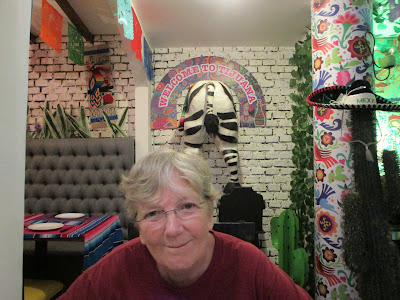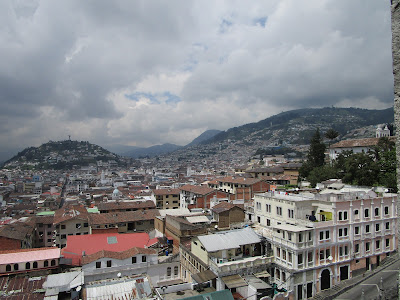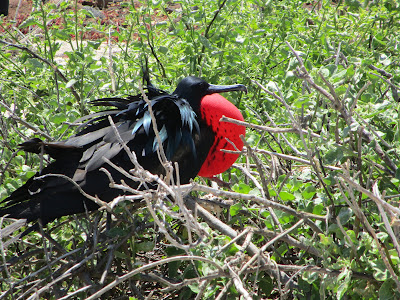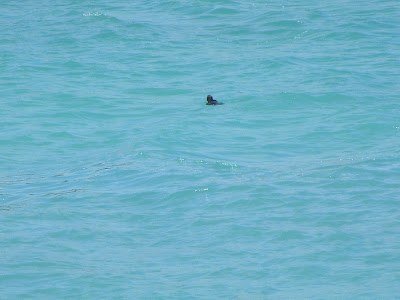Ecuador should have been relatively easy. The currency is the U.S. dollar, and even the electrical outlets are the same as in North America. (This wasn’t true in Peru.) But I felt like we couldn’t quite get the hang of South America.
 |
Photo by Inés Ramos, Museo Nacional, Quito
|
I kept expecting it to be like Southeast Asia: cheap after all those months in the First World, lots of traveling around on buses. That’s how backpacking on the “gringo trail” is described. But the places we went, although in relatively cheap countries, were the most expensive places in those countries. And no wonder, because Machu Picchu and the Galápagos are where most people want to go. Bolivia is probably the least expensive of the Andean countries, but we didn’t go there.
It seemed like we were missing the budget on South America. Another thing that seems obvious, but could complicate your travels if you’re not prepared for it: English really is not widely spoken. In southeast Asia, any tourist-oriented person or business will address you in English, but here I had to ask; and it’s quite likely no one in the office would know any more English than I do Spanish. I always tried to have the conversation, but I was hesitant to put down money or do anything important if I couldn’t find some way of confirming in English.
It is not, of course, remarkable that one should need some Spanish in Spanish-speaking countries. More remarkable is how much of the world we got away with English. In any case, South America was turning out to be our most complicated continent. I remember thinking it was just as well were were doing it last. We’d spent about a year in Oceania and North America, and would have divided our two years of travel about equally between the eastern and western hemispheres.
While we were in Peru and Ecuador, both countries had election campaigns going on.
We who are used to elections, and often disappointed with them or their results, can easily take for granted the basics of democracy, however imperfect. But for much of the twentieth century (never mind before), democracy was the exception in South and Central America, rather than the rule. So I was happy to see people marching in Ecuador, and Peru confronting its violent past through the Truth and Reconciliation Commission.
 Other exciting things were happening in Ecuador. One morning in the wee hours I woke up to that loud clucking sound geckoes make. T. had left an open bottle of Coke on the bedside table (never a good idea) and a gecko had gotten into it! I was just glad T. hadn’t woken up and tried to take a swig. I took the bottle outdoors, thinking the gecko was drowning in there, but it was perfectly fine once I dumped it out. Well, apart from tooth decay.
Other exciting things were happening in Ecuador. One morning in the wee hours I woke up to that loud clucking sound geckoes make. T. had left an open bottle of Coke on the bedside table (never a good idea) and a gecko had gotten into it! I was just glad T. hadn’t woken up and tried to take a swig. I took the bottle outdoors, thinking the gecko was drowning in there, but it was perfectly fine once I dumped it out. Well, apart from tooth decay.
Another morning, back in Guayaquil, I woke up to the sound of the window rattling. It rattled harder and kept going, so I rolled over to wake T., who thought I was having a nightmare. Turned out the first shake of the window was an earthquake near the Peruvian border, 7.5 on the Richter scale! The second was only a 5.5, but felt stronger, because it was so much closer. I was glad we were in a modern apartment building, not that leaky hotel in Galápagos.
 Our Airbnb host, the same one from the last time we were in Guayaquil, had really wanted to show us something that he shows all his guests. We agreed to see it once we were back in town. All I knew was a bit of walking was involved. Well, first he took us to the mall!
Our Airbnb host, the same one from the last time we were in Guayaquil, had really wanted to show us something that he shows all his guests. We agreed to see it once we were back in town. All I knew was a bit of walking was involved. Well, first he took us to the mall!
It was a new, shiny mall, the largest in South America, and our host was clearly so proud of it. It did have the biggest food court I’ve ever seen, and was eerily clean.
Then he took us to a gated community, the public part of which we could walk around. The grand finale of the evening was frozen yogurt with pan de yuca, or cassava bread—kind of like little dough balls. Ever since the ’70s, he told us, Ecuadorians have loved eating these with their frozen yogurt. Sounds kind of odd, but I really liked them. |
| Mexican? Zebra's a$$! |
It wasn’t often that I really liked food. I tried fixed price lunches in Peru, Ecuador, and at a Venezuelan place, but they all seemed to be the same: soup, chicken, rice, beans, and some type of plantain. As in Cuba (and Spain for that matter), nothing came with any kind of spice. If you want anything hot tasting, you need to ask for aji, which is hot sauce on the side. Even a Mexican place we went to disappointed on the chili front. As with the frozen yogurt, the best part was the fresh fruit: icy cold pineapple juice with one lunch, mango the next.
And so, we finally did it: got on a long-distance bus in South America. We were chugging up from the coast to Quito, the capital, whose altitude is 2,850 m. Maybe the cooler weather would prove refreshing to T. Maybe she would be up to a walking tour and other activities she expressed interest in.
 |
| Our Lord, and the speed limit, keeping us safe on the bus |
It took over 7 hours. It was more comfortable than a Tanzanian bus, but didn’t stop any more often. I saw a stork out the window, a sign proudly advertising “Hotel Jhon F. Kennedy,” and lots of pan de yuca stands. Someone on the bus had a dog wearing a diaper (just as well). Someone else, I eventually deduced from the cheeping, had a bird in a cage. At least there was no pig on the roof, like in Vietnam.
The next day in Quito, I was determined to find something different for lunch, and I did. A nice vegetarian cafe had a set menu, along with a very chatty guy who thought, if I was from Canada, I must speak French. Just the fact that I could answer his question in Spanish seemed to impress. I also found a barbershop with a sign saying “Unisex” in the window. The barber tried the same approach as a hairdresser T. had found in Lima: looked on his phone until I found a picture of a haircut that seemed OK. I’ve had worse haircuts for a lot more than $3.50!
I started thinking of this journey in terms of where I’d managed to get a haircut: Aix, Berlin, Trou-aux-Biches, Hanoi, Melbourne (more than once), Honolulu, Phoenix, Toronto. Where after Quito? I wondered.
Next day, the walking tour of Old Town turned out to be more than three hours long. It was just as well, we thought, that T. wasn't up for it. I didn’t know it would take us up the Condor Tower of the Basilica del Voto Nacional.
 |
| Nope. |
Although I didn’t have the shoes to brave the ladders, really, that take you to the top of the tower, I had wanted to see the Basilica. It’s most notable for having gargoyles in the shape of species native to Ecuador.
 |
| Iguanas |
 |
| Jaguars |
 |
| Monkeys |
Through a window opposite the altar, you can also see a unique feature of Quito: the winged figure of the Virgin Mary that stands on top of a hill called Panecillo. I would end up staying near Panecillo and seeing her from many different angles, though I never took a taxi to the top of the hill.
The tour guide then took us to Museu Camilo Egas, featuring an indigenista painter, inside a restored colonial home. And, as I would do many times in the days to come, we crossed Plaza Grande.
The guide also told us something interesting: Ecuadorians study English all through 12 years of school, but then most of them never use English again. Which is why you rarely find someone in Quito who can speak it. There is definitely something wrong with a language teaching system that wastes so much time with something students hate. Someone more enterprising than I could really fill a niche here.
Old Town Quito is a UNESCO World Heritage site. How many World Heritage sites can we count on our travels? More than haircuts, I bet!
The next day, we set out to visit Mitad del Mundo, the monument at the equator. And that, dear reader, is where the wheels finally came off our once-in-a-lifetime big trip.






























































